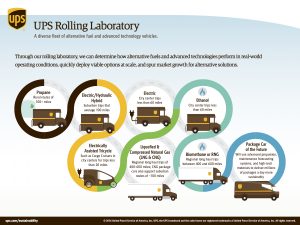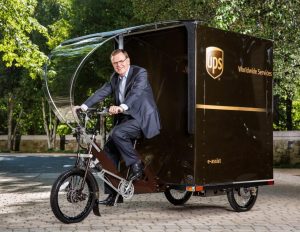We’ve all heard about UPS, the world’s largest package delivery company. On an average day, they deliver around 15.8 million packages to their customers; and according to the UPS Fact Sheet, the global logistics company owns almost 100,000 gasoline vehicles. This has a huge environmental impact, but the people inside UPS realized this problem and are now trying to reduce their carbon footprint. UPS’s Sustainability Strategy consist in reducing the emissions by using alternative fuel vehicles in their delivery process. The goal is to decrease 20% of the carbon emissions by 2020. Nowadays, the company is testing new means of transport, from hybrid and electric trucks to electrically assisted tricycles, in real life situations. 7,000 alternative fuel vehicles are now part of the big fleet.
UPS’s Sustainability Strategy consist in reducing the emissions by using alternative fuel vehicles in their delivery process. The goal is to decrease 20% of the carbon emissions by 2020. Nowadays, the company is testing new means of transport, from hybrid and electric trucks to electrically assisted tricycles, in real life situations. This is what they call the “Rolling Laboratory”. Also, 7,000 alternative fuel vehicles are now part of the big fleet.

UPS Rolling Laboratory Infographic https://sustainability.ups.com/media/UPS_Rolling_Lab.pdf
Although UPS is the biggest logistics company in the world, it keeps working on ways to stand out in the market. They’re constantly thinking on how to overcome the challenges in an innovative way. Some cities, such as Hamburg, are banning the use of large trucks in the city center in order to reduce the emissions. UPS saw this as an opportunity to develop a new vehicle to deliver the packages: the electrically assisted tricycle. This creates a better value proposition for the customers because it’s a way to reach every single person that needs the service in a more efficient way. The creation of this service not only adds value to the company but makes it different, in a good manner, from all the competitors. Also, it shows that the company’s objective goes beyond maximizing profits. By creating the Sustainability Strategy, they demonstrate that they care about the environment and that it’s possible to work on improving the service while taking care of the social responsibility aspect.

UPS CEO David Abney pedaling an electric-assist Cargo Cruiser http://pbs.twimg.com/media/CtnNHr3XgAAUZQJ.jpg
UPS is a great example of a company that can combine the different aspects of a business in an effective way. Social responsibility, differentiation strategy, improving the value proposition for customers. It is the adequate combination of many factors what makes a company better than the others, and this is why UPS keeps being the leader of logistics in the world.
Word count: 417
http://www.citylab.com/work/2012/12/how-ups-delivers-millions-more-fedex/4226/
http://www.forbes.com/sites/joannmuller/2016/09/30/ups-employs-vast-rolling-laboratory-to-discover-clean-truck-of-the-future/#2b9b784d1f31
https://pressroom.ups.com/pressroom/ContentDetailsViewer.page?ConceptType=FactSheets&id=1426321563187-193
http://thenewlogistics.ups.com/sustainable-business/corporate-sustainability/
https://sustainability.ups.com/committed-to-more/fuels-and-fleets/#ground-fleet